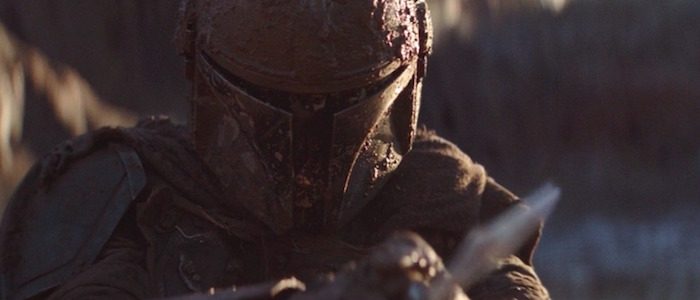
This post contains spoilers for The Mandalorian.
Writing about The Mandalorian episode-to-episode feels like folly, since the show seems so clearly designed for the binge era of streaming. Granted, “Chapter 2: The Child” arrives just three days after “Chapter 1” (which looks discernibly Star Wars but zips past anything discernibly human), though were the gap a traditional seven days, the hook might not have been strong enough to linger in people’s memories and draw them back for more. Yes, there is a little green baby that resembles Master Yoda. No, this infant’s presence doesn’t immediately challenge the Mandalorian — perhaps it might in episode 2?
Alas, the Rick Famuyiwa-directed follow-up offers little by way of intrigue for its central character, though it certainly piques interest if you frequent Wookiepedia. What new factoids might be listed, I wonder, once this new Yoda’s Force powers come to light? When the little green Christmas ornament hobbles toward the injured Mando, it seems to raise its hand in order to heal his wound. The Mandalorian stops him, of course, because the show can’t yet be explicit about what’s patently clear. Not when there are more episodes to be added to the newly-launched Disney+, most of them penned by Jon Favreau of Chef and The Lion King.
Admittedly, I’m being harsh. Although there’s still no emotional hook, the second episode is, in fact, a vast improvement over its predecessor. In trying to evoke Star Wars, the first chapter tossed in visual references galore while speeding through emotional beats. “Chapter 2” is significantly more Star Wars-y, though in a way that might not be immediately obvious given how we tend to define that metric. What we’ve seen thus far may not take place on Tatooine — what is Disney’s Star Wars without an interchangeable desert planet? — and the Jawas and their roaming junk-tank might be ripped right from the first film, but the episode’s quiet atmosphere is what truly gives it its Star Wars DNA.
The episode’s initial scenes are wordless and still, a far-cry from last week’s frantic tone. They feel more akin to R2D2 and C3PO wandering through the desert, than anything featuring Boba Fett. Editor Andrew Eisen lets the Mandalorian breathe, both figuratively and literally. The character’s grunts and sighs are far more audible; they’re part of an increased focus on his physicality this week, since he’s yet to remove his mask. The way he’s allowed to interact with spaces, whether walking far ahead of the baby’s pod, or hunching over and bumping his head in the Jawas’ transport, reveal a grumpiness that feels fitting for his current predicament. The whole thing feels more Lone Wolf and Cub than it does “Pew! Pew!” Rogue One, and thank goodness for that.
Unfortunately, the partially slapstick action — in which the Mando plummets from moving vehicles or is ejected from a cave — can only do so much. There’s still little to augment whatever emotions might be hiding under his helmet, withheld or otherwise. Even the baby Yoda, whose function this week is to react whenever the character is hurt, really doesn’t add much to the suspense. Yoda 2.0 is adorable to look at, but it barely emotes either. Which, of course, is understandable of a baby. But when its function is both to be a lively foil to the probably-reserved Mandalorian — I say “probably” because who’s to know? — as well as to be the point-of-view character in moments the Mando goes “clunk,” its vacant reaction shots to the Mandalorian in mortal danger make for boring television. While the baby may certainly be a Force-centric plot point in future episodes, right now, it serves only to reflect the Mandalorian’s vacuous T-visor, a familiar image that makes emoting an impossible task. (Come on, little fella. Even the Porgs got scared once in a while!)
A faceless character like the Mandalorian is by no means an emotional death sentence, but apart from a few huffs and puffs that make him sound annoyed, little within the show’s fabric is aimed at situating him, or us, emotionally. There’s a certain artlessness to the way he’s lit and shot. No light or shadow, or posture or visual perspective, tells us anything about him, and we certainly can’t rely on his clunky, infrequent dialogue to say much beyond how he feels about his armour. There’s no “why” to his feeling this way, nor are there moments that frame his armoured rigidity as anything but a logistical hurdle. There is nothing weaving together his physical armour with an emotional one — does he even wear emotional armour? It’s hard to tell.
Does this tether to his past prevent the Mandalorian from moving forward, somehow? What would he expose or betray, emotionally speaking, were he to unmask? Refusing to strip himself of his cultural signifiers conflicts only with getting parts of his ship back. However, the image of a man clinging to a cocoon ought to have more weight than that — especially an hour into a story in which he’s featured in every scene. Two episodes in, it turns out a mask-less Mandalorian would have made little difference to the plot. It would, however, have done a world of good to make the show feel mildly conflicting or exciting.
The post ‘The Mandalorian’ Gets Better in Episode Two, But It Desperately Needs to Find Some Direction appeared first on /Film.
from /Film https://ift.tt/2QuDvVR
